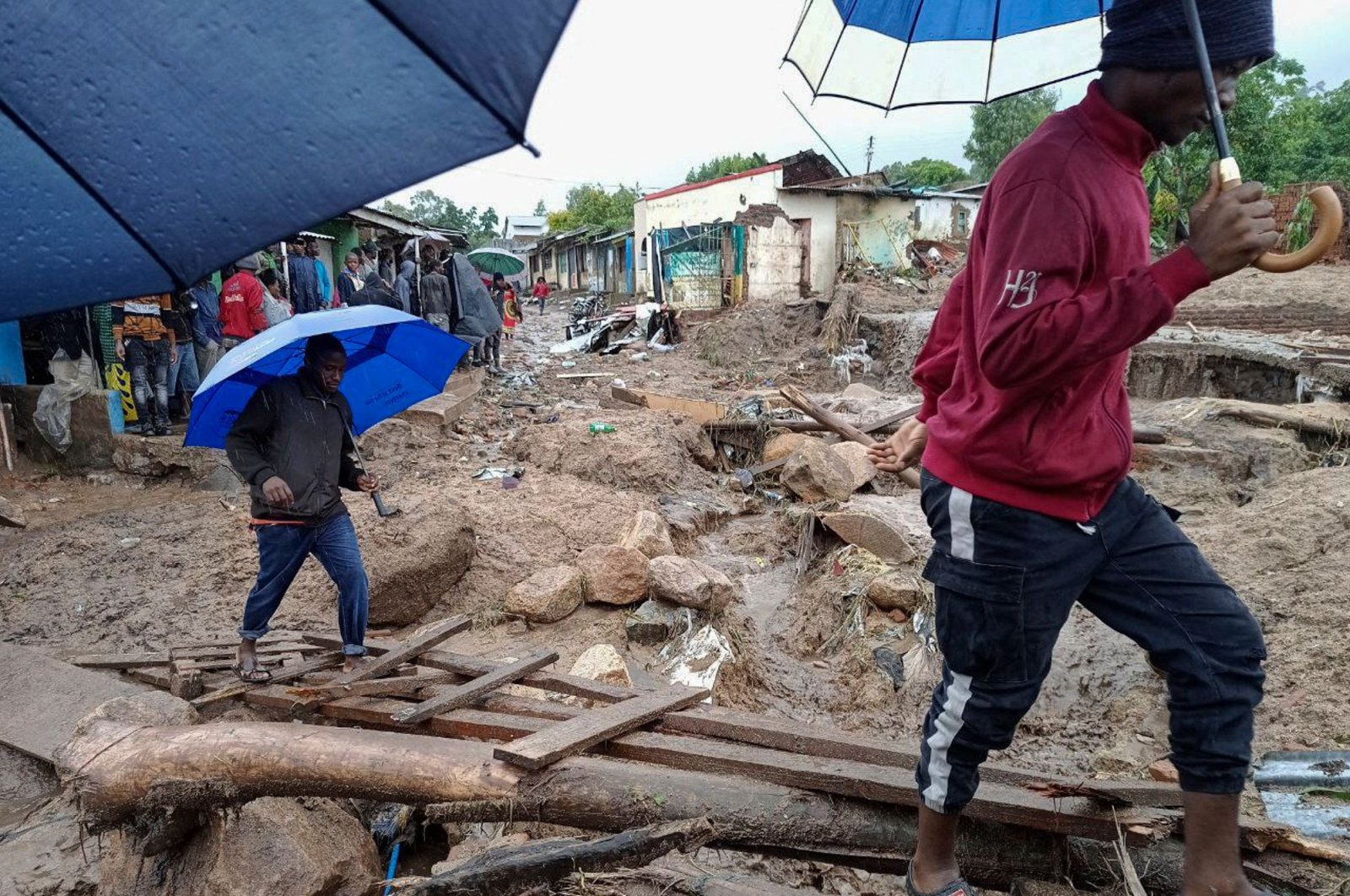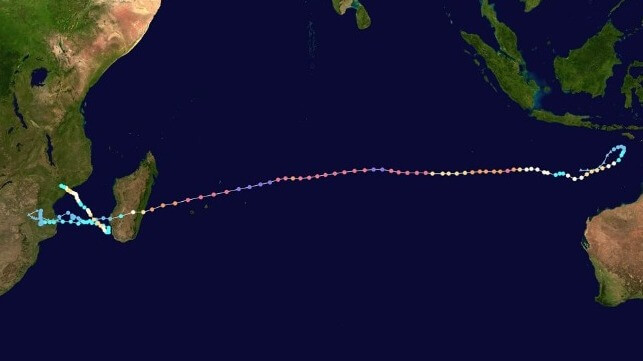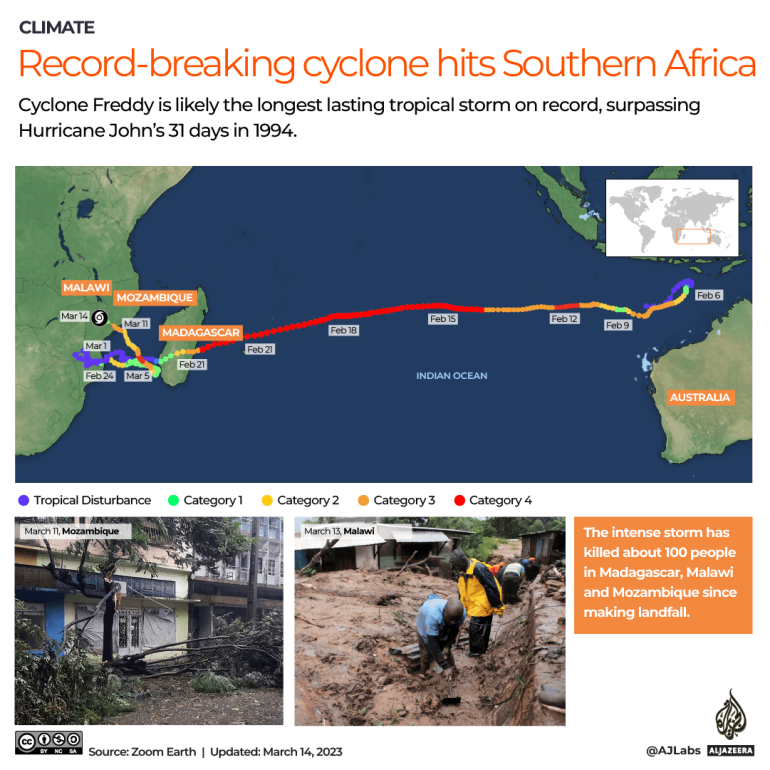CLIMATE CRISIS
Malawi cyclone death toll nears 200 as survivors battle despair
BY AGENCE FRANCE-PRESSE - AFP BLANTYRE, MALAWI MAR 14, 2023 
People cross a makeshift bridge over flood waters in Chimkwankhunda
The death toll from Cyclone Freddy, which slammed Malawi for a second strike, neared 200 on Tuesday as survivors clung to dwindling hopes of finding missing relatives.
At least 190 people have died in the impoverished country since Freddy smashed into southern Africa at the weekend, just weeks after it made a deadly hit in late February, according to a provisional toll.
Many have died in mudslides that have washed away makeshift homes in the country's commercial capital, Blantyre.
Despair settled on Chilobwe, a township on the city's outskirts that accounts for around half of the victims.
Drenched in rains that have been falling for days, survivors milled about in disbelief, looking at flattened houses and structures.
Many believed there were still people trapped underneath the muddy rubble of earthen bricks – but there were no rescuers in sight.
John Witman, in his 80s, in a raincoat and woolen hat, with his 10 family members in tow, stood in front of what was his son-in-law's house. There were just rocks left and gushing water, for the house had been washed away.
"I wish that we could find him, and find closure. We feel helpless because no one is here to help us – we don't know what to do," he told AFP.
In Chimkwankhunda, a district a few kilometers away, Steve Panganani Matera, wearing a high-visibility green jacket, pointed to a mound of mud.
"There were plenty of houses, but they are all gone," said Matera.
"There are plenty of bodies down there in the mud, plenty of bodies."
Deadly loop
Cyclone Freddy reached landlocked Malawi early Monday morning after sweeping through Mozambique at the weekend.
The storm last week broke an unofficial benchmark as the longest-lasting tropical cyclone on record, the U.N.'s World Meteorological Organization (WMO) said Friday.
The confirmed record belongs to a 31-day storm in 1994 named John.
Freddy brewed off weeks ago off the north Australian coast, becoming a named storm on Feb. 6.
It crossed the entire southern Indian Ocean and made landfall in Madagascar on Feb. 21, traversing the island before reaching Mozambique on Feb. 24, claiming nearly two dozen lives in both countries and affecting nearly 400,000 people.
It then returned to the Indian Ocean, refueled on the warmth of its waters, and came back much more powerful at the weekend.
Meteorologists say cyclones that track across the entire Indian Ocean are very infrequent – the last such occurrences were in 2000 – and Freddy's loopback is even more exceptional.
"It's a very rare thing that these cyclones feed themselves over and over again," said climate change expert and professor Coleen Vogel at South Africa's University of the Witwatersrand.
"People aren't expecting them to come back again once they've hit already."
"Climate change is starting to show impacts over these systems," Vogel said, adding however that more research was needed to say this with greater certainty.
More than 11,000 people were affected by the storm in Malawi, according to the U.N.
The cyclone has piled more woes on a country grappling with the deadliest cholera outbreak in its history, which has killed over 1,600 people since last year.
Cyclone Freddy devastates: "A once in a lifetime weather event"
No beds, little food await Malawi Cyclone survivors
Issued on: 14/03/2023 -
Kapeni (Malawi) (AFP) – Wet clothes hang from the windows of a school in Kapeni, a district of Malawi's commercial city of Blantyre, where hundreds of people have sought shelter from deadly Cyclone Freddy.
Packing powerful winds and rain, the cyclone's return triggered floods and mudslides that washed away homes and buried their inhabitants
Mayeso Chinthenga, 14, said he was out fetching for firewood when he and other boys "saw rocks rolling down the mountain" and ran for dear life.
"Some of our neighbours died on the spot", he said. He and his family escaped only with their lives.
"Our house was destroyed. We lost everything," said Chinthenga. "Some of our neighbours died on the spot".
The family-of-five came to Kapeni Demonstration School on Monday after the premises were opened to accommodate some of the at least 19,000 people that authorities say have been displaced by the storm.
"A lot of people arrived here seeking shelter, they said they were running away from the mudslide," said Florence Chiwale, a teacher at the school.
"We decided to open the classrooms for them."
Nearly 200 dead
Almost 200 people have died in Malawi since Freddy pummelled through southern Africa at the weekend for the second time within a few weeks.
Relief workers expect the tally to rise.
About 1,000 survivors are currently living in this makeshift evacuation centre near the hard-hit southern city of Blantyre.
Most are women and children. They sleep on concrete floors, with no mattresses.
Students' desks have been placed against classroom walls to make space for them.
"The classrooms have no lights, we are using solar lamps," said local aid worker Rose Longer.
Outside everything is damp.
Aid is trickling in, but not in large quantities. Most has been provided by well-wishers, said Longer.
"We have distributed rice and beans and drinks that have been donated."
Three women volunteered to prepare meals. They were cooking traditional cornmeal porridge in the school kitchen.
"This is the first food that I have received since I arrived," said Chinthenga, holding a bag of freeze-dried rice with beans and meat.
Government declared a "state of disaster" in the affected regions to allow it pull in emergency resources and respond to the crisis while appealing for local and international aid.
After brewing off Australia in early February, Freddy crossed the Indian Ocean and made landfall on southeastern Africa in late February, before returning at the weekend to deliver a second harder blow.
Cyclone Freddy, which reached landlocked Malawi early Monday morning after sweeping through Mozambique, last week unofficially broke the World Meteorological Organization's benchmark as the longest-lasting tropical cyclone on record.
© 2023 AFP
Record-Setting Cyclone Freddy Makes Third Landfall

Over the weekend, Tropical Cyclone Freddy made its third and final landfall in central Mozambique. This is the cyclone’s third landfall in the area: it arrived on the east coast of Madagascar on February 21 and transited over the southern coast of Mozambique three days later. The first landfall killed 17 and destroyed over 14,000 homes in Madagascar, while the second left 10 people dead and destroyed over 28,000 homes in Mozambique.
Over the course of the last week, Freddy gradually intensified into a tropical cyclone once again over the Mozambique Channel before making a third landfall in the port town of Quelimane, Mozambique on Saturday. Meteorologists have warned that Freddy is a slow-moving cyclone and likely to pick up more moisture over the sea, bringing heavy rainfall. The downpour expected will be in the range of 200mm- 500mm depending on the area.
The World Meteorological Organization (WMO) has described cyclone Freddy as a remarkable storm. It has been swirling for 35 days, crossed the entire South Indian Ocean and traveled more than 8,000 kilometers, from the northwest coast of Australia to Southern Africa.
“This kind of super zonal track is very rare. The most recent recorded cases were Tropical Cyclones Leon-Eline and Hudah, both in 2000, which like 2023 was a La Nina year,” commented WMO.
Preliminary results show that Freddy is likely to have established a new record as the longest-duration tropical cyclone in history. The current record is held by Hurricane John, which lasted 31 days in 1994. However, WMO said that the final determination of record takes time owing to a lengthy review of raw data.
According to NASA, Freddy has set the record for having the highest accumulated cyclone energy (ACE) of any southern hemisphere storm in history. ACE is an index used to measure the total amount of wind energy associated with a tropical cyclone over its lifetime.
 Tropical Cyclone Freddy making its first landfall on the evening of February 21 (EUMETSAT)
Tropical Cyclone Freddy making its first landfall on the evening of February 21 (EUMETSAT)
“World record or not, Freddy will remain in any case an exceptional phenomenon for the history of the South-West Indian Ocean on many aspects: longevity, distance covered, remarkable maximum intensity, accumulated ACE amount and impact on inhabited lands,” said Sebastien Langlade, Head of Operations at WMO’s Regional Specialized Meteorological Center(Meteo-France), Reunion Island.
The severity of cyclones in Southern Africa region has continued to increase in intensity over the last couple of years due to climate change. In 2022 alone, Mozambique experienced two tropical storms and one tropical cyclone (named Gombe). The cyclone affected over 700,000 people and left another 63 dead.
The rise in the number of tropical cyclones in the western Indian Ocean is in tandem with multiple climate projections so far made in the region. Scientists believe that cyclone seasons are being made more intense by the rapidly heating Indian Ocean. Global warming is accelerating the rate of the ocean heating, leading to increased number of cyclones and rapid intensification of weak storms. Cyclones are much more likely to gather intensity over warm waters.
“The entire Indian Ocean is warming at a faster rate compared to the Atlantic or Pacific. And within the Indian Ocean, the western parts of the Indian Ocean are warming much more. We see that sea surface temperature rise is connected with the changes in the intensity and frequency of cyclones,” said Dr. Roxy Mathew Koll, a climate scientist at the Indian Institute of Tropical Meteorology.
Deadly Cyclone Freddy likely to go down as a record-setting storm in multiple ways
Cyclone Freddy has been blamed for more than 100 deaths across three countries and produced over a month’s worth of rain in Mozambique. Despite being an active storm for more than a month, it will still continue to pose several risks, AccuWeather forecasters say.
The deadly and destructive journey for long-lasting Tropical Cyclone Freddy is nearly over after the storm made its third and final landfall more than one month after its initial formation, AccuWeather forecasters say.
After being named on Feb. 6, Freddy took a westward track across the Indian Ocean, spinning from just northwest of Australia all the way to eastern Africa. Freddy has been affecting Madagascar and southeastern Africa for nearly two weeks, making three total landfalls and killing more than 100 people in Madagascar, Mozambique and Malawi.
The death toll surged in Malawi on Monday, as at least 99 deaths were blamed on the storm, with officials saying there were more than 90 injured and 16 people still missing.

People cross a raging river in Blantyre, Malawi, Monday, March 13, 2023. (AP Photo/Thoko Chikondi)
The powerful winds and torrential rain from Freddy have significantly cut communications and electricity supply to Mozambique following its landfall this past weekend. Freddy is now a tropical rainstorm, or an overland depression, according to Meteo France. As such, officials fear that the extent of damage and the number of fatalities may rise.
More than a month's worth of rain has fallen in Mozambique during the past four weeks, according to the BBC. An estimated 1.5 million people have been affected since the storm first hit last month, according to Mozambique's National Disaster Management Agency, and more than 8,000 people are likely to be left homeless.
Freddy has lingered in the Indian Ocean basin as a named tropical cyclone for a total of 35 days and is likely now the longest-lasting named tropical system in history. The previous record was held by Typhoon John in 1994, which survived for 31 days. The World Meteorological Organization is expected to confirm this record in the near future.
Freddy has already gone down in history as a once-in-a-lifetime storm, having broken at least one record.
Freddy took an unusual path across the Indian Ocean and along the eastern African coast during its more than a month-long journey, which included a 15-day trek westward across the open waters of the ocean, before finally making landfall in Madagascar. Freddy then went on to meander through the Mozambique Channel for another two weeks, before two landfalls in Mozambique.

The above image on AccuWeather's Hurricane Tracker shows Freddy's path
across the Indian Ocean from Feb. 6 to its final landfall on March 11.
During that time, Freddy's strength fluctuated, reaching the equivalent of a Category 5 hurricane in the Atlantic or East Pacific Ocean Basins more than once. Freddy was only the 20th tropical cyclone to reach this strength in the South Indian Ocean since 1989. In fact, Freddy re-intensified a total of seven times and traveled more than 5,500 miles.
As a long-duration storm, Freddy's accumulated cyclone energy, referred to as ACE, was exceptionally high. ACE is a measure of a storm's intensity over its lifetime.
According to Colorado State University, the ACE for Freddy is 84.7 as of March 13, which is more than the average total ACE of an entire Atlantic hurricane season. This ACE value is not only the highest ever recorded in the Southern Hemisphere, but it's also close to the total ACE of Hurricane Ioke from 1980, the current world record-holder for a single cyclone at around 85.

The above AccuWeather RealVue Satellite shows Freddy making landfall in Madagascar on Feb. 21.
After more than a month prowling the Indian Ocean and wreaking havoc over land, forecasters say Freddy could still pose additional concerns.
AccuWeather Meteorologist Alyssa Smithmyer says that Freddy is likely to drift southeastward over the next few days, continuing to become disorganized as it moves back into the Mozambique Channel.
Freddy has gone through this area frequently in recent weeks, promoting the upwelling of the waters in the channel. Upwelling is the process of very cold water, deep below the ocean surface being mixed in with the warmer water at the surface. Powerful tropical systems naturally will do this when they move through a body of water.

This Meteosat-9 satellite shows Tropical Cyclone Freddy ahead of its first landfall
in Mozambique on Friday, Feb. 24, 2023. (Photo/NOAA)
"The recent upwelling in the region has brought ocean surface temperatures down low enough that it would be unlikely for Freddy to regain wind intensity," Smithmyer explained, adding that an increase in wind shear over the region will also likely be an inhibiting factor.
However, the lingering moisture from Freddy could push into southern parts of Madagascar for the middle of the week, adding even more rain to the already drenched area.
Cyclone Freddy death toll in Malawi, Mozambique passes 100
With bare hands, Malawians dig through mud for survivors; Mozambique officials say fallout from the storm’s second landfall was worse than expected.
Published On 14 Mar 202314 Mar 2023
More than 100 people have been killed in Malawi and Mozambique after Cyclone Freddy, packing powerful winds and torrential rain, returned to Southern Africa’s mainland.
Freddy barrelled through Southern Africa at the weekend for the second time in a few weeks, making a comeback after it first hit in late February.
Malawi bore the brunt, counting at least 99 deaths after mudslides overnight washed away houses and sleeping occupants.
Another 134 people were injured and 16 are reported missing. Malawi’s commercial capital Blantyre recorded 85 deaths.
“We expect the number to rise,” Charles Kalemba, a commissioner at the Department of Disaster Management Affairs, told a press conference on Monday.
In neighbouring Mozambique, at least 10 people died and 14 were wounded.
The Mozambique National Institute for Disaster Management said the fallout from the storm’s second landfall in the country was worse than expected.
According to the UN’s World Meteorological Organization, Freddy, which formed off northwestern Australia in the first week of February, was set to become what is believed to be the longest lasting tropical cyclone on record. It crossed the entire southern Indian Ocean and blasted Madagascar from February 21 before reaching Mozambique on February 24.
Following what meteorologists describe as a “rare” loop trajectory, Freddy then headed back towards Madagascar before moving once more towards Mozambique.
The last cyclones to cross the entire southern Indian Ocean were Leon-Eline and Hudah in 2000.
The UN said more than 11,000 people were affected by the storm.
The impact of the cyclone has piled more woes on Malawi, a country grappling with the deadliest cholera outbreak in its history, which has killed more than 1,600 people since last year.
President Lazarus Chakwera declared a “state of disaster in the Southern region” of the nation. The government was responding to the crisis while appealing for local and international aid for affected families, his office said.
Schools in 10 southern districts will remain closed until Wednesday, with rains and winds expected to keep battering the nation’s south.
National carrier Malawi Airlines said all flights to Blantyre have been cancelled until further notice after an inbound plane ran into the bad weather and was forced back to the capital, Lilongwe.
The country’s energy utility also warned that electricity generation would be unstable, as it would have to temporarily shut down hydropower stations to prevent muddy water from damaging turbines.
Armed with shovels or just their bare hands, residents of the southern Malawi township of Chilobwe were digging through the mud, hoping to find survivors as the torrential rain unleashed by Cyclone Freddy poured on their backs.
Government rescuers were late to arrive, said one resident refusing to give his name, covered in mud, as he helped with the rescue effort.
“The people are overwhelmed. The situation is very difficult,” said ambulance driver Honest Chirwa, adding rescuers lacked adequate equipment.
The impoverished township has been hit hard by the powerful storm, which triggered flooding and mudslides that swept away homes and buried their inhabitants.

Many of the Malawi deaths were in Chilobwe, a hillside settlement near Malawi’s second-largest city, Blantyre.
“There was a huge mudslide that dragged down several houses. It was bad,” said Donald Banda, a 16-year-old student. He is among about 100 residents searching for their neighbours, dead or alive.
The mudslide struck overnight and destroyed everything in its wake, Banda said, with several houses and their occupants disappearing almost instantly.
Most of the houses in the area are built with mud bricks, making them easily susceptible to damage under harsh weather.
“We have no choice but to do this all on our own,” said the man, who asked not to be identified by name. “It is frustrating because people are dying.”
SOURCE: NEWS AGENCIES


















